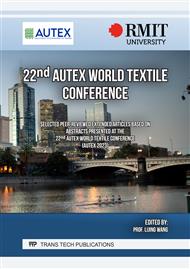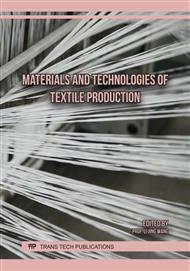[1]
Rashid, M. M. et al. (2021). Recent advances in TiO2-functionalized textile surfaces. Surfaces and Interfaces, 22, 100890.
DOI: 10.1016/j.surfin.2020.100890
Google Scholar
[2]
Nasikhudin, et al. (2018). Study on Photocatalytic Properties of TiO2 Nanoparticle in various pH condition Journal of Physics: Conference Series, 1011, 12069.
Google Scholar
[3]
Vahl, A. et al. (2019). Pathways to tailor photocatalytic performance of TiO2 thin films deposited by reactive magnetron sputtering. Materials, 12, 2840.
DOI: 10.3390/ma12172840
Google Scholar
[4]
Tian, J., et al. (2016). Ru nanoparticles decorated TiO2 nanobelts: A heterostructure towards enhanced photocatalytic activity and gas-phase selective oxidation of benzyl alcohol. Cheramics International, 42, 1611–1617.
DOI: 10.1016/j.ceramint.2015.09.112
Google Scholar
[5]
Abbas. W. A., et al. (2019). Recent advances in the use of TiO2 nanotube powder in biological, environmental, and energy applications. Nanoscale Advances, 1, 2801–2816.
Google Scholar
[6]
Etacheri, V., et al. (2015). Visible-light activation of TiO2 photocatalysts: Advances in theory and experiments. Journal of Photochemistry and Photobiology C: Photochemistry Reviews, 25, 1–29.
DOI: 10.1016/j.jphotochemrev.2015.08.003
Google Scholar
[7]
Rahimi, N. et al. (2016). Review of functional titanium oxides. I: TiO2 and its modifications. Progress in Solid State Chemistry, 44, 86–105.
DOI: 10.1016/j.progsolidstchem.2016.07.002
Google Scholar
[8]
Kumar, S. G., Rao, K. S. R. (2017). Comparison of modification strategies towards enhanced charge carrier separation and photocatalytic degradation activity of metal oxide semiconductors (TiO2, WO3 and ZnO). Applied Surface Science, 391, 124–148.
DOI: 10.1016/j.apsusc.2016.07.081
Google Scholar
[9]
Nam, Y., et al. (2019). Photocatalytic activity of TiO2 nanoparticles: a theoretical aspect. Journal of Materials Chemistry A, 7, 13833.
Google Scholar
[10]
Shen, R., et al. (2019). Surface and interface engineering of hierarchical photocatalysts. Applied Surface Science, 471, 43–87.
Google Scholar
[11]
Sirivallop, A., et al. (2020). Enhanced visible light photocatalytic activity of N and Ag doped and co-doped TiO2 synthesized by using an in-situ solvothermal method for gas phase ammonia removal. Catalysts, 10, 251.
DOI: 10.3390/catal10020251
Google Scholar
[12]
Demirci, S., et al. (2016). Synthesis and characterization of Ag doped TiO2 heterojunction films and their photocatalytic performances. Applied Surface Science, 390, 591–601.
DOI: 10.1016/j.apsusc.2016.08.145
Google Scholar
[13]
Santos, L. M., et al. (2015). Structural characterization of Ag-doped TiO2 with enhanced photocatalytic activity. RSC Advances, 5, 103752.
Google Scholar
[14]
Jaksik.J., et al. (2018). Advanced cotton fibers exhibit efficient photocatalytic self-cleaning and antimicrobial activity. Journal of Photochemistry & Photobiology A: Chemistry, 365,77–85.
DOI: 10.1016/j.jphotochem.2018.07.037
Google Scholar
[15]
Elshahawy, M. F., et al. (2020). Fabrication of TiO2 reduced graphene oxide based nanocomposites for efective of photocatalytic decolorization of dye efuent. Journal of Inorganic and Organometallic Polymers and Materials, 30, 2720–2735.
DOI: 10.1007/s10904-020-01463-3
Google Scholar
[16]
Wang, F., Zhang, K. (2011). Reduced graphene oxide–TiO2 nanocomposite with high photocatalystic activity for the degradation of rhodamine B. Journal of Molecular Catalysis A: Chemical, 345, 101–107.
DOI: 10.1016/j.molcata.2011.05.026
Google Scholar
[17]
Gu, Y., et al. (2014). Synthesis and photocatalytic activity of graphene based doped TiO2 nanocomposites, Applied Surface Science, 319, 8–15.
DOI: 10.1016/j.apsusc.2014.04.182
Google Scholar
[18]
Ul-Islam, S. (Ed.), Butola, B. S. (Ed.) (2019). Advanced functional textiles and polymers (1st ed.). John Wiley & Sons, Inc. (Hoboken, NJ) and Scrivener Publishing LLC (Beverly, MA).
Google Scholar
[19]
Shabbir, M. (Ed.), Ahmed, S. (Ed.), Sheikh, J. N. (Ed.) (2020). Frontiers of textile materials. Polymers, Nanomaterials, Enzymes, and Advanced modification techniques (1st ed.). John Wiley & Sons, Inc. (Hoboken, NJ) and Scrivener Publishing LLC (Beverly, MA).
DOI: 10.1002/9781119620396
Google Scholar
[20]
Kim, Y.-K., Min, D.-H. (2013). UV protection of reduced graphene oxide films by TiO2 nanoparticle incorporation. Nanoscale, 5, 3638–3642.
DOI: 10.1039/c3nr00321c
Google Scholar
[21]
Tayebi, M., et al. (2019). Reduced graphene oxide (RGO) on TiO2 for an improved photoelectrochemical (PEC) and photocatalytic activity. Solar Energy, 190, 185–194.
DOI: 10.1016/j.solener.2019.08.020
Google Scholar



